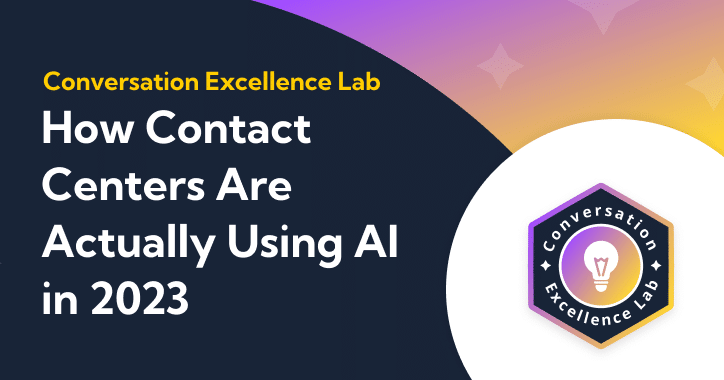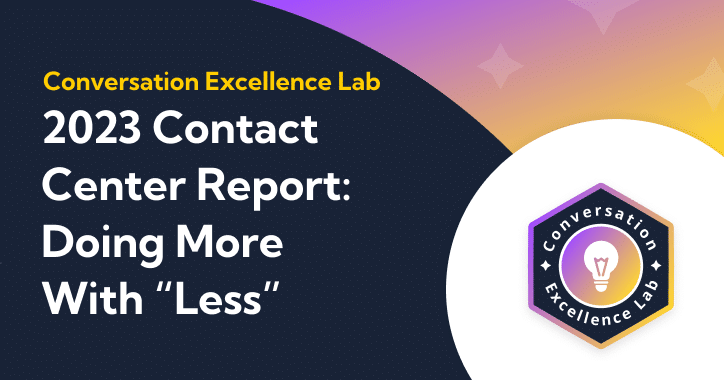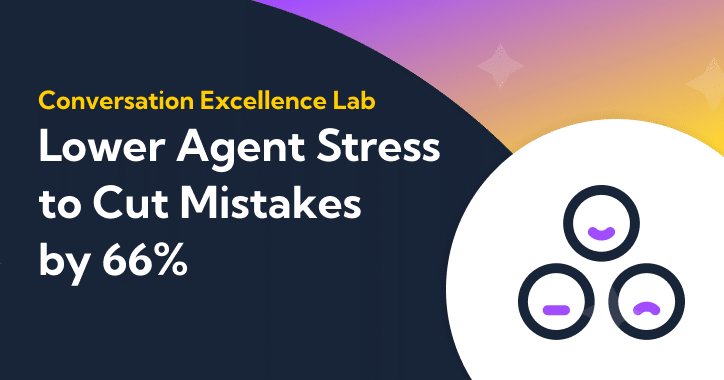“What will the contact center of 2030 look like?” Marc Bernstein asks the guests on his podcast, “Reimagining the Contact Center.” To date, over forty industry experts have shared their visions for contact centers in ten years, from Rob Siefker, the Senior Director of Customer Loyalty at Zappos, to Stephen Yep, the Director of the Call Centre Management Association. Read through some of our favorite responses here.
The consensus: humans are here to stay. The contact center agent of the future is highly specialized and uses AI technology to serve customer needs efficiently and effectively across a broad variety of channels: voice, chat bot, text message, social media, and more.
To test our experts’ predictions, we recently asked over 360 contact center executives which channels they use most today, and which channels they think will be most prevalent ten years from now. We found:
- Voice assistance and live chat with a human remained in the top three most used channels both today and ten years from now.
- The channels with the most fluctuation in the next ten years were social media, online chat bots, and IVR — but not in the directions you would expect.
Subscribe to future Conversation Excellence Lab reports below:
People Aren’t Going Anywhere…
We asked 361 executives to rank the following channels in order of how important they are to their operations today, and how important they foresee them being ten years from now.
Today, the top three were live chat with a human, voice (phone) assistance, and email. Our respondents predicted that the top three would not change in ten years: live chat with a human would remain in the number one spot, while voice assistance and email would switch places as numbers two and three, respectively.
Figure 1: Service Channels Used Today vs. In Ten Years
What does this tell us? The executive consensus is not to eliminate humans from contact centers in the next ten years and replace them entirely with AI. Rather, humans will stay front and center as a critical part of contact center operations, and AI will serve to bolster their performance rather than supplant it.
The contact center is going to be a much more high-touch expert environment. Imagine entire contact centers filled with [expert teams]… your AIs will be handling the transaction side of it. The human element will always be there because you need the person-to-person connection for certain things, especially enterprise sales or anything to do with high ticket items. But also, at the end of the day, people just want to at least connect and make sure that there is another human being on the other side. That’s sales, right? It’s the transference of trust between one person and another.
Michael McMillan, CEO of BizSprints and ProximoCX
A McKinsey report found that only 5% of jobs are fully automatable. Agents in the contact center of 2030 will be highly specialized experts. The things that can be automated will be, and the remainder will be complex interactions that require a human element.
Considering the increased complexity of the calls agents will be taking, they’ll need to be experts in emotional intelligence as well as the subject matter at hand. “In many ways, I think we’re going to see a higher expectation for resolution… a more holistic approach to contact,” says Joey Coleman, the Chief Experience Composer at Design Symphony. “I think when we think about contact centers, there’s going to be an opportunity to foster connections within the customer base or within the tribe, through the non-business related conversations that are more aspirational or more communal.”
…But Channels Will Change
Even though the top three channels above did not change, we found a good deal of shifting among the other channels. Social media moved from #5 to #9, online non-human chatbots moved from #8 to #5, and IVR (Interactive Voice Response) assistance moved from #9 to #6. Let’s look at each of these shifts.
Social Media
While social media support has grown in the past few years as a service differentiator, industry executives see themselves using it less ten years than they do today. Why is that? The most obvious is this: social media may be a powerful tool for certain industries, like direct-to-consumer retail, but its impact on customer satisfaction for other industries may not meet the mark.
For example, consumers may not want to interact with their utilities provider via Instagram, or direct message their insurance company on TikTok. There are industries and products where a social media presence makes sense from a branding perspective and those where it does not.
There are also costs to maintaining a consistent and on-brand social media presence: the operational spend of generating content, employing individuals to curate it, and maintaining timeliness in responding to messages. While having a social media presence can help you garner new customers, it can also expose you to a town hall in a comments section or potentially go viral for slip-ups that can damage your brand.
It makes sense that companies would try out social media as a support tool — social media usership is projected to reach six billion in 2027, around 77% of today’s population — but it also makes sense that many of them might ultimately decide to take a step back from it considering the factors above.
Non-human chatbots and IVR
Online non-human chatbots and IVR assistance both moved up in predictions for contact centers in the next ten years. This tracks well with our experts’ assertions that everything that can be automated, will be automated.
In terms of how businesses can leverage automation or get better about self-service, we’ll continue to see the highly repetitive tasks drop out of human-to-human interaction. That will happen through an app or a website or an interactive IVR. What we’re going to be left with are the interactions that are complicated and nuanced. That’s my bet on what we’ll see.
Justin Robbins, Senior Director of Corporate Communications & Evangelism at ujet.cx.
So if you want to know a store’s hours or get an update on when your delivery is arriving, you’ll be able to quickly get that information without having to speak with a human — but when things go wrong or you need to talk through a complex situation, there will always be a human on the other end of the line.
Read more in our full report: “How to Recession-Proof Your Contact Center, According to 360+ Executives.”
Sources
Balto. (2021, December 13). What Does the Contact Center of 2030 Look Like? - Balto Ai. RSS. Retrieved September 6, 2022, from https://www.balto.ai/blog/what-does-the-contact-center-of-2030-look-like/
Balto. (2022, August 3). How to Recession-Proof Your Contact Center, According to 360+ Executives - Balto Ai. RSS. Retrieved September 6, 2022, from https://www.balto.ai/research/how-to-recession-proof-your-contact-center/
Bernstein, M. Reimagining the Contact Center - with Marc Bernstein. Apple Podcasts. Retrieved September 26, 2022, from https://podcasts.apple.com/us/podcast/reimagining-the-contact-center-with-marc-bernstein/id1550447943
Das, A.C., Gomes, M., Patidar, I.L., & Thomas, R. (2022, April 27). Social media as a service differentiator: How to win. McKinsey & Company. Retrieved September 26, 2022, from https://www.mckinsey.com/business-functions/operations/our-insights/social-media-as-a-service-differentiator-how-to-win
Dixon, S. (2022, July 26). Number of global social network users 2018-2027. Statista. Retrieved September 26, 2022, from https://www.statista.com/statistics/278414/number-of-worldwide-social-network-users/
McKinsey Global Institute. (2017, January). A Future That Works: Automation, Employment, and Productivity. McKinsey & Company. Retrieved September 26, 2022, from https://www.mckinsey.com/~/media/mckinsey/featured%20insights/Digital%20Disruption/Harnessing%20automation%20for%20a%20future%20that%20works/MGI-A-future-that-works-Executive-summary.ashx






